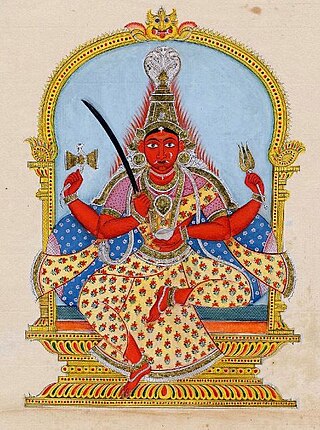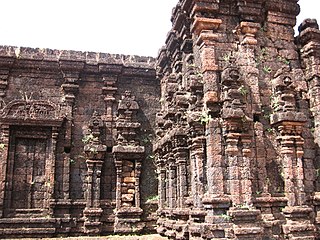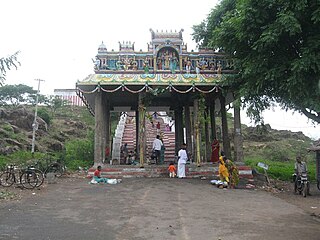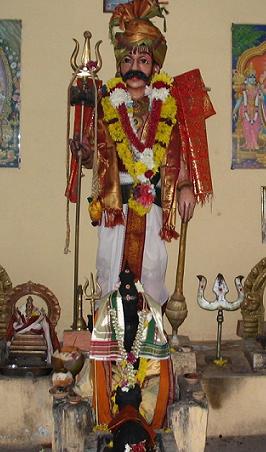
Bangsar is a residential suburb on the outskirts of Kuala Lumpur, lying about 4 kilometres (2.5 mi) south-west of the city centre. It is part of the Lembah Pantai parliamentary constituency. Bangsar is administered by Dewan Bandaraya Kuala Lumpur (DBKL), unlike other townships in the Klang Valley such as Petaling Jaya and Subang Jaya which have their municipal councils. Neighbourhood residents' associations and business councils play a part in communicating with the local authority, but they exercise no legal or administrative power. Malays make up most of the population at 61%, followed by the Chinese at 24%, Indians at 15%.

Mariamman, often abbreviated to Amman, is a Hindu goddess of weather, predominantly venerated in the rural areas of South India. Her festivals are held during the late summer/early autumn season of Ādi throughout Tamil Nadu and the Deccan region, the largest being the Ādi Thiruviḻa. Her worship mainly focuses on bringing rains and curing diseases like cholera, smallpox, and chicken pox. Mariamman is worshipped in accordance with local traditions such as Pidari or the Gramadevatai. She is considered as a guardian deity by many South Indian village-dwellers. She is also the regional form of hindu goddess Parvati. Her consort is lord Shiva. At samayapuram, she is the sister of Ranganathaswamy. She is also worshipped in Karnataka as Marikambe, who is a manifestation of Adi-Parashakti or Mahadevi.

The Rajarajeshwara temple is a Shiva temple located in Taliparamba in Kannur district of Kerala State of India. The temple is regarded as one of the existing 108 ancient Shiva Temples of ancient Kerala. It also has a prominent place amongst the numerous Shiva temples in South India. It had the tallest shikhara amongst the temples of its time. The Rajarajeshwara temple has a top of about 90 tonnes. If any problem is encountered in the other temples of South India, devotees seek a solution in this temple through a prashnam, a traditional method of astrological decision-making. The prashnam is conducted on a peedha outside the temple.

Kundrathur is a town located in the Chennai Metropolitan Area and the headquarters of Kundrathur taluk in Kanchipuram District. It is the birthplace of Sekkizhar, a well-known poet-saint who authored the Periyapuranam.

The Sri Mahamariamman Temple is the oldest Hindu temple in Kuala Lumpur, Malaysia. Founded in 1873, it is situated at the edge of Chinatown in Jalan Bandar. In 1968, a new structure was built, featuring the ornate 'Raja Gopuram' tower in the style of South Indian temples.

The Arulmigu Sri Mahamariamman Temple is a Hindu temple within George Town in the Malaysian state of Penang. The oldest Hindu temple in the state, it was built in 1833, and features sculptures of gods and goddesses over its main entrance and facade.

The Vilwadrinatha Temple is a Hindu temple in Thiruvilwamala, a town in the city of Thrissur, Kerala, India. The principal deities are Rama, the seventh incarnation of the god Vishnu, and his brother, Lakshmana. It figures among the Abhimana Kshetrams in Vaishnavite traditions. This is one of the four major Rama temples in Kerala — the other three are in Thriprayar, Kadavallur, and Thiruvangad. The temple houses an idol of Lakshmana, which is rare in India. Vilwadrinatha Temple is located in the centre of the community of Thiruvilwamala, atop a 100-foot-high hillock. Visible from the temple is Bharathappuzha, the second-largest river in Kerala, which flows past the temple's northern side from around 3 kilometres away.

Karuppusamy, also known as Karuppu or Karuppannaswamy(Tamil: கருப்பண்ணசுவாமி Malayalam: കറുപ്പണ്ണസാമി ),(lit. 'Black God' or 'Black') is a Hindu god in Tamil Nadu, popular among the social groups of Tamil Nadu and Kerala and also Sri Lanka. He is one of 21 guardian deities of Ayyanar, and is one of 21 guardian deities in Dravidian folk religion.

The Sri Kandaswamy Kovil is a Hindu temple located along Jalan Scott, Brickfields in Kuala Lumpur, Malaysia. The temple is over a century old.

Muneeswarar, or Muneeswaran, is a popular Hindu deity within Hinduism, and is worshipped by many, in countries such as India, Malaysia, Singapore, Indonesia, Fiji and many more. He is sometimes referred to by different names, such as Muniyandi, Muniyappan, Muni Ayya, Ayya amongst many others. Muneeswarar is mostly considered a guardian deity or minor, but is in some cases hierarchically considered to be on par with Lord Shiva, one of the main deities in the Hindu trinity. Although not much is known on the exact origins and history of Muneeswarar, he is often regarded to be related to the Hindu Lord Shiva. His name is a combination of "Muni", and "Ishvara", an epithet or title of Shiva.

Sri Maha Mariamman Temple, also known as Maha Uma Devi Temple (Thai: วัดพระศรีมหาอุมาเทวี; RTGS: Wat Phra Si Maha Umathewi and Wat Khaek in Thai, is a South Indian architecture style Hindu temple on Si Lom Road in Bangkok, Thailand. It was built in 1879 by Vaithi Padayatchi, a Tamil Hindu immigrant.
Sri Sithi Vinayagar Temple is a Hindu temple located along Jalan Selangor in Petaling Jaya, Selangor, Malaysia. It is also generally referred to as the PJ Pillaiyar Temple. The resident deity is Ganesha in the form of Sri Sithi Vinayagar. The temple is said to be the largest temple in Malaysia dedicated to Lord Ganesha.

The Arulmigu Sri Rajakaliamman Glass Temple is a Hindu temple in Johor Bahru, Johor, Malaysia. It is also one of the state's tourist attractions. The temple was listed in the Malaysian Book of Records as the first and only glass temple in the nation on 12 May 2010.

Sri Poyatha Moorthi Temple is the oldest existing/intact Hindu temple in Malaysia and one of the oldest functioning Hindu temples in Maritime Southeast Asia. Located in the state of Malacca, the temple is one of the few existing Chitty temples in Malaysia.

Sri Lakshmi Narasimhar Temple is located about 55 km from Chennai and 21 km from Arakkonam, in Narasingapuram, Thiruvallur. The temple is dedicated to Hindu deity Narasimha, who is avatar of Vishnu and his consort Lakshmi. From the days of glory and grandeur that prevailed in South India the temple of Lakhsmi Narasimha at Narasingapuram still boasts the era of Cholas and Vijayanagara Rayas. The Lakshmi Narasimha Temple is situated in the village of Narasingapuram in Thiruvallur district.

Pachaimalai Arulmigu Subramanya Swamy Temple, also known as the Pachaimalai Balamurugan Temple, is one of the two major hill temples located in Gobichettipalayam, Tamil Nadu, India. The temple is dedicated to the Lord Murugan. The temple is constructed in the Tamil style of architecture and is located on top of a small hillock in the outskirts of the town of Gobichettipalayam near Pudupalayam, Tamil Nadu. Here, Kartikeya is venerated as Balamurugan or Subramanya Swamy.

The Arulmigu Balathandayuthapani Temple, also known as the Waterfall Hilltop Temple, is a Hindu temple within George Town in the Malaysian state of Penang. Dedicated to Lord Murugan, the hilltop temple, with its seven-storey 21.6 m-tall gopuram, has been touted as the largest Lord Murugan temple outside India. It is sited comparatively higher above ground than Batu Caves, with devotees having to climb over 500 steps to access the place of worship.

Little India Ipoh, is one of the major business centers of Malaysian Indians in Ipoh, Perak, Malaysia.
The Hindu Mahajana Sangam is an association of Indian workers. It is one of the Indian non-profitable organization at Penang, Malaysia which has been officially established in 1935 by waterfronts workers. Before 1935, it known as Kootakkadai .
Arulmigu Prasanna Venkatachalapathy temple, Tallakulam is a Vaishnavite temple, constructed by King (Mannar) Thirumalai Naicker, dating back to 600 years ago. This temple is under purview of the administration of Kallalagar temple of Azhagar koil, of Madurai district. Goddesses here in this temple are 'Poodevi' and 'Sridevi'. Utsavar is named Srinivasar. This temple's Theertha is 'well water'. Hanuman is found to be in a posture of 'anger mode' and opposite to that is situated Chakkaraththaazhvaar.

















